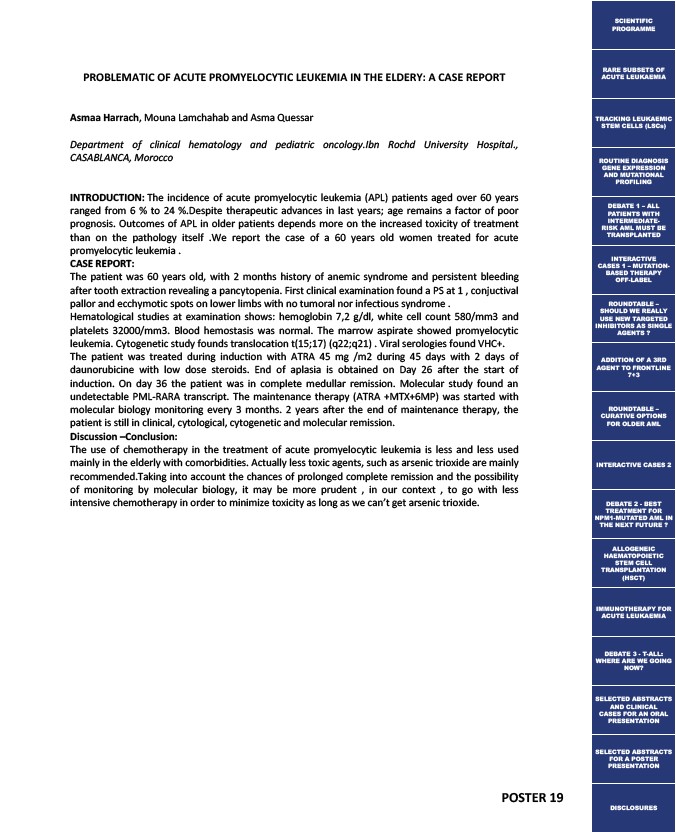
PROBLEMATIC OF ACUTE PROMYELOCYTIC LEUKEMIA IN THE ELDERY: A CASE REPORT
POSTER 19
Asmaa Harrach, Mouna Lamchahab and Asma Quessar
Department of clinical hematology and pediatric oncology.Ibn Rochd University Hospital.,
CASABLANCA, Morocco
INTRODUCTION: The incidence of acute promyelocytic leukemia (APL) patients aged over 60 years
ranged from 6 % to 24 %.Despite therapeutic advances in last years; age remains a factor of poor
prognosis. Outcomes of APL in older patients depends more on the increased toxicity of treatment
than on the pathology itself .We report the case of a 60 years old women treated for acute
promyelocytic leukemia .
CASE REPORT:
The patient was 60 years old, with 2 months history of anemic syndrome and persistent bleeding
after tooth extraction revealing a pancytopenia. First clinical examination found a PS at 1 , conjuctival
pallor and ecchymotic spots on lower limbs with no tumoral nor infectious syndrome .
Hematological studies at examination shows: hemoglobin 7,2 g/dl, white cell count 580/mm3 and
platelets 32000/mm3. Blood hemostasis was normal. The marrow aspirate showed promyelocytic
leukemia. Cytogenetic study founds translocation t(15;17) (q22;q21) . Viral serologies found VHC+.
The patient was treated during induction with ATRA 45 mg /m2 during 45 days with 2 days of
daunorubicine with low dose steroids. End of aplasia is obtained on Day 26 after the start of
induction. On day 36 the patient was in complete medullar remission. Molecular study found an
undetectable PML-RARA transcript. The maintenance therapy (ATRA +MTX+6MP) was started with
molecular biology monitoring every 3 months. 2 years after the end of maintenance therapy, the
patient is still in clinical, cytological, cytogenetic and molecular remission.
Discussion –Conclusion:
The use of chemotherapy in the treatment of acute promyelocytic leukemia is less and less used
mainly in the elderly with comorbidities. Actually less toxic agents, such as arsenic trioxide are mainly
recommended.Taking into account the chances of prolonged complete remission and the possibility
of monitoring by molecular biology, it may be more prudent , in our context , to go with less
intensive chemotherapy in order to minimize toxicity as long as we can’t get arsenic trioxide.
SCIENTIFIC
PROGRAMME
RARE SUBSETS OF
ACUTE LEUKAEMIA
TRACKING LEUKAEMIC
STEM CELLS (LSCs)
ROUTINE DIAGNOSIS
GENE EXPRESSION
AND MUTATIONAL
PROFILING
DEBATE 1 – ALL
PATIENTS WITH
INTERMEDIATE-RISK
AML MUST BE
TRANSPLANTED
INTERACTIVE
CASES 1 – MUTATION-BASED
THERAPY
OFF-LABEL
ROUNDTABLE –
SHOULD WE REALLY
USE NEW TARGETED
INHIBITORS AS SINGLE
AGENTS ?
ADDITION OF A 3RD
AGENT TO FRONTLINE
7+3
ROUNDTABLE –
CURATIVE OPTIONS
FOR OLDER AML
INTERACTIVE CASES 2
DEBATE 2 - BEST
TREATMENT FOR
NPM1-MUTATED AML IN
THE NEXT FUTURE ?
ALLOGENEIC
HAEMATOPOIETIC
STEM CELL
TRANSPLANTATION
(HSCT)
IMMUNOTHERAPY FOR
ACUTE LEUKAEMIA
DEBATE 3 - T-ALL:
WHERE ARE WE GOING
NOW?
SELECTED ABSTRACTS
AND CLINICAL
CASES FOR AN ORAL
PRESENTATION
SELECTED ABSTRACTS
FOR A POSTER
PRESENTATION
DISCLOSURES